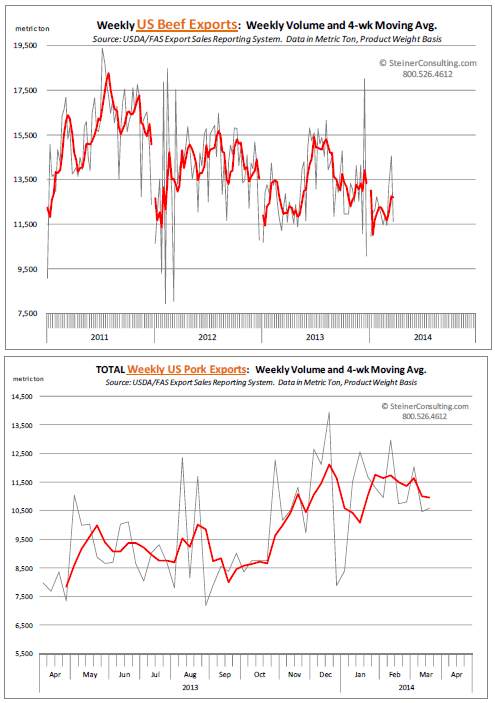



CME: Volume of Pork, Beef Exported More Resilient than Expected
US - The sharp spike in US beef and pork prices so far this year was expected to significantly reduce the volume of US products going to export markets, write Steve Meyer and Len Steiner.In February, USDA had pegged US beef exports for 2014 down 9.6 per cent compared to a year ago, a forecast that was then revised up in March, with the latest estimate showing a 5.7 per cent decline in US beef exports in 2014.
Some are tempted to say that the increase in US prices will negatively impact export demand but that is not the right way to think about it. Rather, the higher prices simply cause other markets to purchase less product assuming a steady demand curve (demand is a schedule of prices and quantities).
So far, however, the volume of US beef and pork going to other markets has been more resilient than what one would expect and we think export demand for US beef and pork remains strong. It could be that this is because short term demand tends to be inelastic.
Also, in the short term, the higher prices actually could cause some foreign buyers to buy more not less, depending on expectations for future prices. For instance, if a buyer in another country relies on a steady supply of US raw material and wants to make sure that they have enough inventory until they can find another supplier, they are more likely to place more orders so as to cover their needs for that period of time.
In the case of pork, the jump in futures prices and forecasts of sharply higher US pork prices in the summer may have caused some exporters to stockpile some product in order to keep prices in check for their customers.
Furthermore, some markets have a very strong seasonality in their purchases of US product. Japan, for instance, tends to buy a lot of US beef in Q2 and a good portion of those purchases are items such as short plates and briskets.
We would argue that part of the reason why brisket, plate and 50CL beef prices were so strong in late February and March is because export buyers were quite aggressively purchasing at a time when retail demand also was quite strong.
It made for an explosive market for some items and helped underpin cattle values. So what do weekly export numbers show? For the last four reported weeks (through March 20) US weekly beef exports averaged 12,713 MT, 0.5 per cent lower than the previous four week average but 6 per cent higher than the same four week period a year ago.
As for the drivers of this year over year increase, largely it is exports to Asian markets but exports to Mexico also have been much stronger than expected. Exports to Hong Kong for the four week period were up 123 per cent compared to a year ago.
China beef demand remains extremely strong as consumers there appear to have shifted some of their purchases away from chicken (bird flu) and pork (disease concerns). Exports to Japan have accelerated in recent weeks and they are currently running ahead of last year’s levels.
For the last four weeks, exports to Japan were up 14 per cent while exports to S. Korea increased 20 per cent. One big wild card in US beef exports to Japan, S. Korea and Hong Kong is the pace of cattle slaughter in Australia.
In the last 12 months, Australian producers have struggled with drought conditions, which has caused a dramatic liquidation of their herds. Should fall and winter in Australia bring more rains, it could reduce overall slaughter there, which would mean Japanese and S. Korean buyers may turn to the US, even with current record high prices.
As for pork sales, we have yet to see a shift down in export shipments. While the pork export data still has problems, it is still a timely indicator as to the overall trend and so far, pork export volumes are strong, despite the spike in prices.







